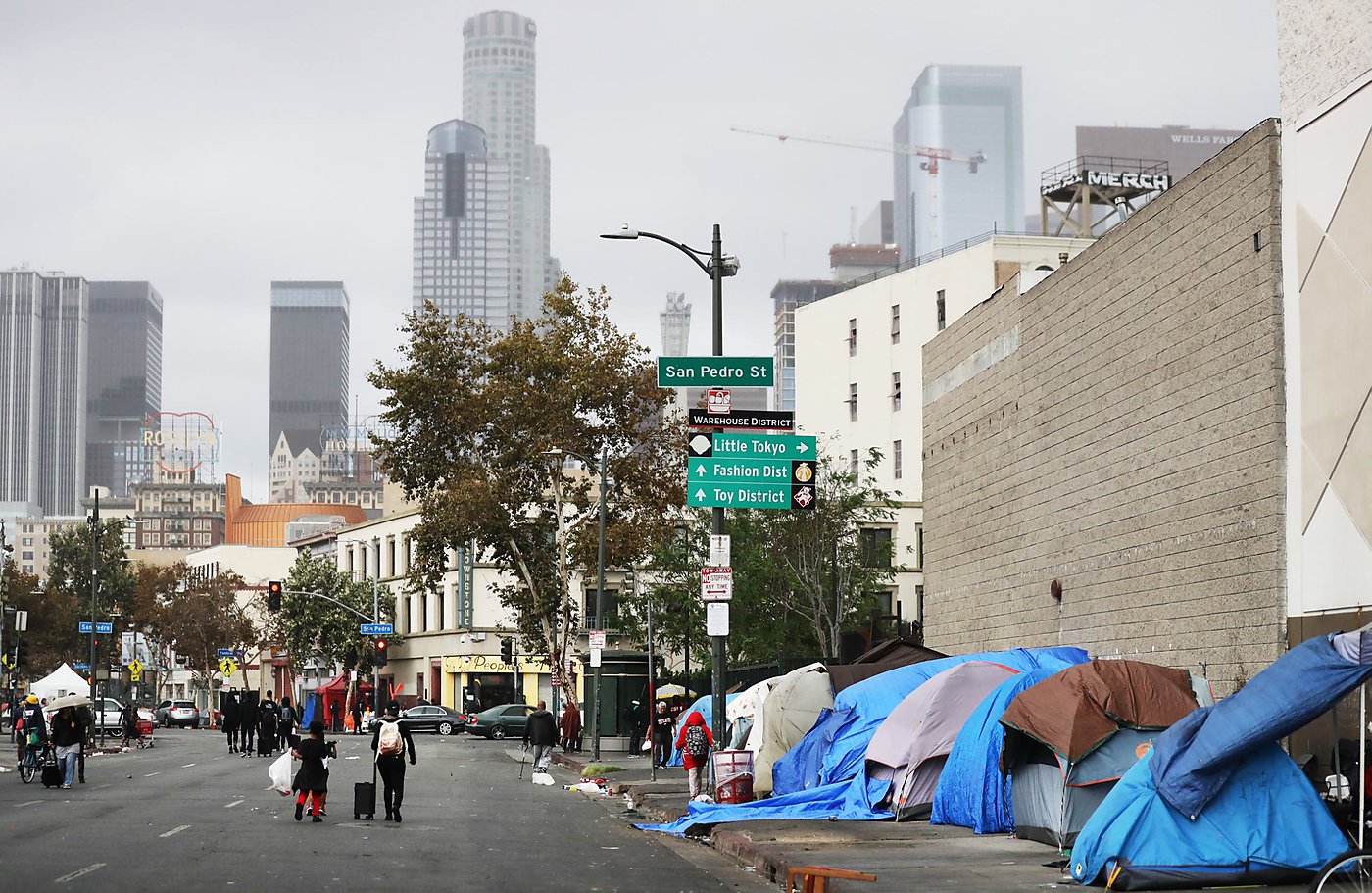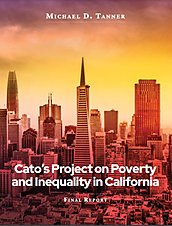1. Phil Willon and Taryn Luna, “California Homelessness Crisis Is ‘a Disgrace,’ Newsom Says in State of the State Address,” Los Angeles Times, February 19, 2020.
2. Raj Chetty, Nathaniel Hendren, and Lawrence Katz, “The Effects of Exposure to Better Neighborhoods on Children: New Evidence from the Moving to Opportunity Project,” American Economic Review 106, no. 4 (2016): 855–902.
3. “Household Expenditures and Income,” Pew Charitable Trusts, March 30, 2016.
4. “2021 California Housing Profile,” National Low Income Housing Coalition, updated July 19, 2021.
5. Jesús Fernández-Villaverde and Lee Ohanian, “Housing Policy Reform,” in Scott Atlas et al., Economic Policy Challenges Facing California’s Next Governor (Stanford, CA: Hoover Institution, 2018), pp. 15–19.
6. “Selected Housing Characteristics,” American Community Survey, U.S. Census Bureau, 2019, https://data.census.gov/cedsci/table?q=california%20rent&tid=ACSDP1Y2019.DP04.
7. Anna Marie Erwert, “$3,500 to Rent a Studio? In San Francisco, Yes,” SFGate, May 13, 2018.
8. Chris Salviati, “Housing Shortage: Where Is the Undersupply of New Construction Worst?,” Apartment List, July 26, 2017.
9. Hans Johnson, Julien Lafortune, and Marisol Cuellar Mejia, “California’s Future: Housing,” Public Policy Institute of California, January 2020.
10. “Poverty Thresholds,” U.S. Census Bureau, last revised February 2, 2021, https://www.census.gov/data/tables/time-series/demo/income-poverty/historical-poverty-thresholds.html; and “Median Gross Rent by Bedrooms,” American Community Survey, U.S. Census Bureau, 2018, https://data.census.gov/cedsci/table?q=median%20rent%20californai&tid=ACSDT1Y2018.B25031.
11. Robert P. Jones et al., “A Renewed Struggle for the American Dream: PRRI 2018 California Workers Survey,” Public Religion Research Institute, August 28, 2018.
12. “Percentage of People in Poverty by State Using 2- and 3‑Year Averages: 2015–2016 and 2017–2018,” Income and Poverty in the United States: 2018, U.S. Census Bureau, last revised September 10, 2019.
13. “Table A‑5: Number and Percentage of People in Poverty by State Using 3‑Year Average Over: 2016, 2017 and 2018,” The Supplemental Poverty Measure: 2018, U.S. Census Bureau, last revised August 12, 2020.
14. Housing Crisis: 805 (Ventura: Central Coast Alliance United for a Stable Economy, 2019).
15. Peter Mateyka, “Desire to Move and Residential Mobility: 2010–2011,” Household and Economic Studies, U.S. Census Bureau, March 2015.
16. Rebecca Cohen and Keith Wardrip, “Should I Stay or Should I Go? Exploring the Effects of Housing Instability and Mobility on Children,” Center for Housing Policy, February 2011.
17. Matthew Desmond, “Unaffordable America: Poverty, Housing, and Eviction,” Fast Focus no. 22–2015, Institute for Research on Poverty, University of Wisconsin–Madison, March 2015.
18. Matthew Desmond and Carl Gershenson, “Housing and Employment Insecurity among the Working Poor,” Social Problems 63, no. 1 (February 2016): 46–67.
19. Heather Sandstrom and Sandra Huerta, “The Negative Effects of Instability on Child Development: A Research Synthesis,” Urban Institute Low-Income Working Families Discussion Paper 3, September 2013.
20. Cohen and Wardrip, “Should I Stay or Should I Go?”
21. “Selected Housing Characteristics,” American Community Survey, U.S. Census Bureau, 2018, https://data.census.gov/cedsci/table?q=crowded%20housing&hidePreview=false&tid=ACSDP5Y2018.DP04&t=Housing&vintage=2018.
22. Jonathan Woetzel et al., “A Tool Kit to Close California’s Housing Gap: 3.5 Million Homes by 2025,” McKinsey & Company, October 2016.
23. “California’s Housing Future: Challenges and Opportunities—Final Statewide Housing Assessment 2025,” California Department of Housing and Community Development, February 2018.
24. Mac Taylor, California’s High Housing Costs: Causes and Consequences (Sacramento: California Legislative Analyst’s Office, 2015), p. 33.
25. Taylor, California’s High Housing Costs.
26. “Table 2au: New Privately Owned Housing Units Authorized Unadjusted Units for Regions, Divisions, and States,” U.S. Census Bureau, 2017, https://www.census.gov/construction/bps/txt/tb2u2017.txt.
27. The Regional Housing Needs Allocation process is flawed, and California should consider repealing it—if the other reforms discussed herein are enacted. Instead of market forces, such as high demand for housing in jobs-rich areas, determining where new homes get built, the state has given authority over this to regional planning agencies. The market and price signals will more efficiently determine the need for new housing than a planning agency can, especially given that planning agencies allocate housing over eight-year cycles. It’s hard to make predictions eight years in advance about anything, let alone where people will want to live and work. Regional planning agencies have certainly improved and pushed back against exclusionary policies in recent years, but we can’t forget that those same agencies (not to mention city planning departments) created the mess that California is in now by making it too hard to build or funneling housing inland, as well as perpetuating institutional racism in the form of housing segregation.
28. Governor Newsom’s administration has sued Huntington Beach to force compliance and has tied homeless aid to participation in Regional Housing Needs Allocation. Julia Sclafani and Liam Dillon, “State Lawsuit Targeting Huntington Beach over Housing Could End with New Plan,” Daily Pilot, January 11, 2020.
29. Nikie Johnson, “Report Card: How We Graded Every City, County in California on Meeting RHNA Housing Permit Goals,” Mercury News, February 1, 2021; and Shannan West, letter from the land use and planning unit chief to San Diego Mayor Kevin L. Faulconer, California Department of Housing and Community Development, October 1, 2020, https://www.hcd.ca.gov/community-development/housing-element/docs/sdisandiegocityadopt10022020.pdf.
30. Paavo Monkkonen, “Planning for Housing in Southern California: Closing the ‘Beverly Hills Loophole,’” Urbanize Los Angeles, June 18, 2019.
31. Paavo Monkkonen and Spike Friedman, “Not Nearly Enough: California Lacks Capacity to Meet Lofty Housing Goals,” Lewis Center for Regional Policy Studies Policy Brief, University of California, Los Angeles, February 2019.
32. Brian Goggin, “Measuring the Length of the Housing Development Review Process in San Francisco,” Terner Center for Housing Innovation Professional Report, University of California, Berkeley, 2018.
33. Moira O’Neill, Giulia Gualco-Nelson, and Eric Biber, “Examining the Local Land Use Entitlement Process in California to Inform Policy and Process,” Berkeley Law Center for Law, Energy, and the Environment Working Paper no. 2, University of California, Berkeley, 2019.
34. Liam Dillon, Ben Poston, and Julia Barajas, “Affordable Housing Can Cost $1 Million in California. Coronavirus Could Make It Worse,” Los Angeles Times, April 9, 2020.
35. See, for example, Christopher Silver, “The Racial Origins of Zoning in American Cities,” in Urban Planning and the African American Community: In the Shadows, eds. June Manning Thomas and Marsha Ritzdorf (Thousand Oaks, CA: Sage Publications, 1997).
36. Conor Dougherty, Golden Gates: Fighting for Housing in America (New York: Penguin Press, 2020).
37. Roderick Hills, Jr. and David Schleicher, “Balancing the ‘Zoning Budget,’” Regulation 34, no. 3 (Fall 2011): 24–32.
38. Mark Baldassare et al.,” Statewide Survey, Californians and Their Government,” Public Policy Institute of California, February 2020.
39. Richard Rothstein, The Color of Law: A Forgotten History of How Our Government Segregated America (New York: Liveright Publishing, 2017).
40. Mac Taylor, “The 2016–17 Budget: Considering Changes to Streamline Local Housing Approvals,” California Legislative Analyst’s Office, May 18, 2016, https://lao.ca.gov/reports/2016/3470/Streamline-Local-Housing-Approvals.pdf.
41. Edward L. Glaeser, Joseph Gyourko, and Raven Saks, “Why Is Manhattan So Expensive? Regulation and the Rise of Housing Prices,” Journal of Law and Economics 48, no. 2 (2005): 331–69.
42. Edward L. Glaeser, Joseph Gyourko, and Raven Saks, “Why Have Housing Prices Gone Up?,” American Economic Review 95, no. 2 (May 2005): 329–33.
43. Joseph Gyourko and Jacob Krimmel, “The Impact of Local Residential Land Use Restrictions on Land Values across and within Single Family Housing Markets,” National Bureau of Economic Research Working Paper no. 28993, July 2021.
44. Josh Cohen, “California ADU Applications Skyrocket after Regulatory Reform,” Next City, January 4, 2018.
45. “SB‑9 Housing Development: Approvals,” California Legislative Information, August 16, 2021, https://leginfo.legislature.ca.gov/faces/billNavClient.xhtml?bill_id=202120220SB9.
46. Michael Manville, Paavo Monkkonen, and Michael Lens, “It’s Time to End Single-Family Zoning,” Journal of the American Planning Association 86, no. 1 (December 6, 2019): 1–7; and Emily Hamilton, “Land Use Regulation and Housing Affordability,” in Regulation and Economic Opportunity: Blueprints for Reform, eds. Adam Hoffer and Todd Nesbit (Logan: Center for Growth and Opportunity at Utah State University, 2020).
47. Taylor, California’s High Housing Costs.
48. For more information on this, see Sanford Ikeda and Emily Hamilton, “How Land-Use Regulation Undermines Affordable Housing,” Mercatus Center, November 4, 2015.
49. Michael Manville, “Parking Requirements and Housing Development: Regulation and Reform in Los Angeles,” ACCESS no. 44 (Spring 2014): 2–9.
50. “Reducing Housing Costs by Rethinking Parking Requirements,” in A Housing Strategy for San Francisco (San Francisco: SPUR, June 1, 2006).
51. Andrew Bowen, “City Council OKs Sweeping Urban Parking Reforms,” KPBS, March 4, 2019.
52. “AB-1401 Residential and Commercial Development: Remodeling, Renovations, and Additions: Parking Requirements,” California Legislative Information, June 21, 2021, https://leginfo.legislature.ca.gov/faces/billHistoryClient.xhtml?bill_id=202120220AB1401.
53. Mary Salmonsen, “JLL Capital Markets Closes $4.1 Million Sale of 16-Unit Tecela Little Havana,” Multifamily Executive, August 26, 2021.
54. For a historical perspective, see Thomas D. Horne, “Zoning: Setback Lines: A Reappraisal,” William and Mary Law Review 10, no. 3 (1969). Oakland’s setback requirements, for reference, can be found in “Residential Zones—Summary of Regulations,” City of Oakland Community and Economic Development Agency, revised September 28, 2012, http://www2.oaklandnet.com/oak/groups/ceda/documents/report/oak040065.pdf.
55. Edward L. Glaeser, Jenny Schuetz, and Bryce Ward, “Regulation and the Rise of Housing Prices in Greater Boston,” Pioneer Institute for Public Policy Research and Rappaport Institute for Greater Boston, January 5, 2006.
56. “The Tiny House Movement,” Tiny Home Builders, https://www.tinyhomebuilders.com/help/tiny-house-movement; and Kristin Hanes, “How to Live in a Tiny House without Breaking the Law,” Realtor.com, January 23, 2018.
57. Brian Rosenthal, “Density Is New York City’s Big ‘Enemy’ in the Coronavirus Fight,” New York Times, March 23, 2020.
58. “New York State Department of Health COVID-19 Tracker,” New York State Department of Health, https://covid19tracker.health.ny.gov/.
59. “COVID-19 Data,” New York City Department of Health and Mental Hygiene, https://www1.nyc.gov/site/doh/covid/covid-19-data.page.
60. Justin Fox, “Density Isn’t Destiny in the Fight against Covid-19,” Bloomberg Opinion, April 7, 2020.
61. Evan Mast, “The Effect of New Market-Rate Housing Construction on the Low-Income Housing Market,” W. E. Upjohn Institute for Employment Research Working Paper no. 19–307, July 1, 2019.
62. Brian J. Asquith, Evan Mast, and Davin Reed, “Supply Shock versus Demand Shock: The Local Effects of New Housing in Low-Income Areas,” W. E. Upjohn Institute Working Paper no. 19–316, December 19, 2019.
63. “A ministerial duty is imposed on a person in public office who, because of that position, is obligated to perform in a legally prescribed manner when a given state of facts exists.… A ministerial duty is one that does not involve any independent judgment or discretion.” Christine Dietrick and Jon Ansolabehere, “Land Use 101: A Field Guide,” City of San Luis Obispo, p. 3.
64. O’Neill, Gualco-Nelson, and Biber, “Examining the Local Land Use Entitlement Process.”
65. Winter King, “Tips for Using the Subdivision Map Act to Fight Bad Development,” Eye on the Environment, February 2015.
66. California Coastal Commission, When Do You Need a Coastal Development Permit?, https://www.coastal.ca.gov/enforcement/cdp_pamphlet.pdf.
67. Taylor, California’s High Housing Costs.
68. Carol Galante, “Why By-Right Affordable Housing in California Is the Right Thing to Do,” Terner Center for Housing Innovation, University of California, Berkeley, May 24, 2016.
69. Evan Sernoffsky and Dominic Fracassa, “Feds Charge SF Public Works Director Mohammed Nuru with Fraud,” San Francisco Chronicle, updated February 5, 2020.
70. “Streamlined Ministerial Approval Process Guidelines,” § 301(a)(1), California Department of Housing and Community Development, November 29, 2018.
71. O’Neill, Gualco-Nelson, and Biber, “Examining the Local Land Use Entitlement Process.”
72. “Streamlining Affordable Housing Approvals—Proposed Trailer Bill,” 2016, https://web.archive.org/web/20160616005531/http:/www.dof.ca.gov/budgeting/trailer_bill_language/local_government/documents/707StreamliningAffordableHousingApprovals_000.pdf.
73. Taylor, “Considering Changes to Streamline Local Housing Approvals.”
74. Adrian Glick Kudler, “There’s a Last Minute Rush to Completely Overhaul California’s Big Environmental-Development Law,” Curbed Los Angeles, August 23, 2012.
75. Justin Ewers, “Where Things Stand on CEQA: Steinberg Still Pushing for Reform,” California Forward, January 17, 2013; Andreas Borgeas, “When It Comes to California Environmental Review, Legislation Is Better than Lawsuits,” Fresno Bee, January 17, 2020; Borre Winckel, “It’s Time to Take CEQA Reform Seriously,” Voice of San Diego, July 9, 2019; and Alastair Bland, “Weakling or Bully? The Battle over CEQA, the State’s Iconic Environmental Law,” CalMatters, updated June 23, 2020.
76. Woetzel et al., “A Tool Kit to Close California’s Housing Gap.”
77. Taylor, California’s High Housing Costs.
78. Jennifer Hernandez, David Friedman, and Stephanie DeHerrera, In the Name of the Environment: How Litigation Abuse under the California Environmental Quality Act Undermines California’s Environmental, Social Equity and Economic Priorities—and Proposed Reforms to Protect the Environment from CEQA Litigation Abuse (Miami: Holland & Knight, 2019).
79. Hernandez, Friedman, and DeHerrera, In the Name of the Environment.
80. “Infill Development Projects—Class 32 Categorical Exemption Special Requirement Criteria,” Los Angeles Department of City Planning, July 23, 2018.
81. Hernandez, Friedman, and DeHerrera, In the Name of the Environment.
82. Sarah Mawhorter, David Garcia, and Hayley Raetz, “It All Adds Up: The Cost of Housing Development Fees in Seven California Cities,” Terner Center for Housing Innovation, University of California, Berkeley, March 20, 2018.
83. Mawhorter, Garcia, and Raetz, “It All Adds Up.”
84. “Editorial: California Housing Prices Are Too Damn High. Cities Can Help Change That if They Want To,” Los Angeles Times, February 28, 2020.
85. “Data Base on Historical Finances of State and Local Governments: ‘Govt_Finances,’ Fiscal Years 1957–2008,” U.S. Census Bureau, August 2010, https://www2.census.gov/programs-surveys/gov-finances/datasets/historical/Govt_Finances.zip; and “2018 State and Local Government Finance Historical Datasets and Tables,” U.S. Census Bureau, 2018, https://www.census.gov/programs-surveys/gov-finances/data/datasets.2018.html.
86. “Data Base on Historical Finances of State and Local Governments,” U.S. Census Bureau; and “2018 State and Local Government Finance Historical Datasets and Tables,” U.S. Census Bureau.
87. “Data Base on Historical Finances of State and Local Governments,” U.S. Census Bureau; and “2018 State and Local Government Finance Historical Datasets and Tables,” U.S. Census Bureau.
88. “AB-678 Housing Development Projects: Fees and Exactions Cap,” California Legislative Information, March 25, 2021. The bill was introduced in the Assembly on February 12, 2021.
89. Janie Har and Daisy Nguyen, “Governor: 16,000 Hotel Rooms to House Homeless in California,” Associated Press, April 18, 2020. Even before the onset of COVID-19, public health officials were worried about the spread of diseases such as hepatitis in the homeless community. Francine Kiefer and Martin Kuz, “Housing Crisis or Health Crisis? On the Streets of California, It’s Both,” Christian Science Monitor, April 2, 2020. On San Diego’s Hepatitis A outbreak, see “San Diego Hepatitis Outbreak Ends after Two Years,” Associated Press, October 30, 2018.
90. “2007–2019 Point-in-Time Estimates by CoC,” Department of Housing and Urban Development, https://www.hud.gov/sites/dfiles/Main/documents/2007–2019_PIT_Counts_by_CoC.XLSX.
91. Kate Anthony et al., “Homelessness in the San Francisco Bay Area: The Crisis and a Path Forward,” McKinsey & Company, July 11, 2019.
92. “2007–2019 Point-in-Time Estimates by CoC,” Department of Housing and Urban Development.
93. “Greater Los Angeles Homeless Count: 2019 Results,” Los Angeles Homeless Services Authority, updated June 17, 2020, p. 20, https://www.lahsa.org/documents?id=3437–2019-greater-los-angeles-homeless-count-presentation.pdf; and “Greater Los Angeles Homeless Count: 2020,” Los Angeles Homeless Services Authority, June 12, 2020, p. 23, https://www.lahsa.org/documents?id=4558–2020-greater-los-angeles-homeless-count-presentation.
94. Marina Fisher et al., “California’s New Vagrancy Laws: The Growing Enactment and Enforcement of Anti-Homeless Laws in the Golden State,” Berkeley Law Policy Advocacy Clinic, February 12, 2015, http://dx.doi.org/10.2139/ssrn.2558944.
95. “Punishing the Poorest: How the Criminalization of Homelessness Perpetuates Poverty in San Francisco,” San Francisco Coalition on Homelessness, 2015.
96. “Punishing the Poorest,” San Francisco Coalition on Homelessness.
97. “Punishing the Poorest,” San Francisco Coalition on Homelessness.
98. “Punishing the Poorest,” San Francisco Coalition on Homelessness.
99. “Punishing the Poorest,” San Francisco Coalition on Homelessness.
100. “California Department of Corrections and Rehabilitation: Several Poor Administrative Practices Have Hindered Reductions in Recidivism and Denied Inmates Access to In-Prison Rehabilitation Programs,” California State Auditor Report 2018-113,” January 2019, http://www.auditor.ca.gov/pdfs/reports/2018–113.pdf.
101. Joe Khalil, “Governor Signs Conservatorship Bill to Address State’s Growing Homeless Population,” FOX 40 News, October 2, 2019.
102. Liam Dillon and Benjamin Oreskes, “Homeless Shelter Opponents Are Using This Environmental Law in Bid to Block New Housing,” Los Angeles Times, May 15, 2019.
103. Liam Dillon, “This Bill Would Let New Homeless Shelters and Affordable Housing Bypass Environmental Law,” Los Angeles Times, January 8, 2020.
104. Hillary Davis, “Land-Use Restrictions Play into Newport Beach Homeless Shelter Search,” Los Angeles Times, September 8, 2019.










